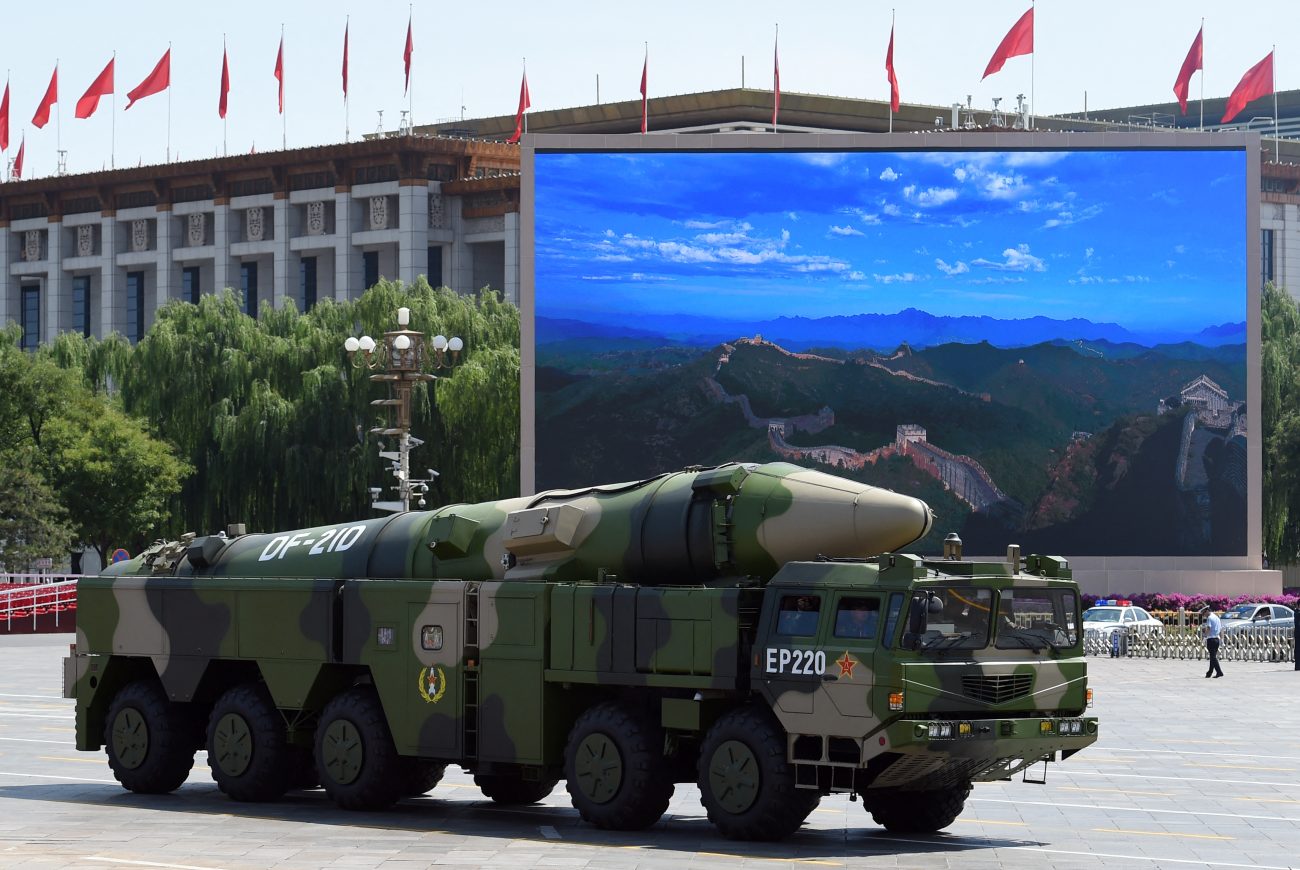If anything, the latest yearbook of the Swedish thinktank Stockholm International Peace Research Institute (SIPRI) has confirmed the apprehensions of the strategic elites in general and those associated with the U.S. Department of Defense in particular that China possesses more warheads than the UK and France combined and that it is expanding its arsenal faster than any other nation.
Since 2023, Beijing has added approximately 100 new warheads annually, marking a significant escalation in its nuclear capabilities.
What is confounding the experts is China’s seemingly non-transparent nuclear expansion and the growing ambiguity over its stated nuclear strategy that Beijing always keeps its nuclear capabilities at minimum level, that it follows a policy of “no first use” of nuclear weapons, and that it is committed to not using or threatening to use nuclear weapons against non-nuclear weapon states and nuclear-weapon-free zones.
In its report released on June 16, SIPRI said that China has the world’s fastest-growing nuclear arsenal, adding about 100 warheads to its arsenal every year since 2023. At present, China has at least 600 nuclear warheads, it said.
Remarkably, SIPRI’s estimate is similar to that of the Pentagon’s latest “China Military Power Report,” released in December 2024, which also stated that China had over 600 operational nuclear warheads. It had even talked of China being on track to grow its arsenal to 1,000 warheads by 2030.
According to SIPRI, China could have as many intercontinental ballistic missiles (ICBMs) as those of the U.S. or Russia by 2030. However, SIPRI has clarified that its maximum nuclear warheads, which could reach up to 1,500 by 2035, will remain fewer than those of either Washington or Moscow.
The U.S. has 5,177 warheads, while Russia has 5,459, according to SIPRI estimates.
As of January 2025, China had completed or was nearing completion of around 350 ICBM silos across three desert regions in the north and three mountainous areas in the east.
The Chinese manner of organizing its forces could match the ICBM counts of Russia or the United States by the end of the decade, according to the SIPRI report.
“Depending on how it decides to structure its forces, China could potentially have at least as many ICBMs as either Russia or the USA by the turn of the decade, although its stockpile of nuclear warheads is still expected to remain much smaller than the stockpiles of either of those two countries”.
SIPRI said that after China upgraded its DF-5 ICBMs with multiple independently targetable re-entry vehicles (MIRVs) – enabling each missile to carry several warheads capable of striking different targets – it had also deployed the DF-41 missile equipped with MIRV technology within the past five years.
If China eventually filled each of its new silos under construction with a single-warhead missile, it would have the capacity to deploy around 650 warheads on its ICBMs within another decade, but if each silo were filled with a missile equipped with three MIRVs, this number could rise to more than 1,200 warheads, SIPRI said.
However, the rise in the number of states with multiple-warhead programmes could potentially lead to a “rapid increase in deployed warheads” and allow nuclear-armed states, especially China, to “threaten the destruction of significantly more targets”, SIPRI cautioned.
On its part, the Pentagon report had said that according to its assessment, China’s new Dongfeng-27 (DF-27) missile, which can be configured either as an intermediate-range or intercontinental ballistic missile, has a hypersonic glide vehicle payload option. Further, the report said that China “may have deployed” the DF-27 missile with this capability to its rocket force.
Incidentally, on June 4, China’s state broadcaster CCTV had, for the first time, released some of the key specifications of the DF-5, an ICBM that could deliver a single nuclear warhead with an explosive yield of between 3 and 4 megatons of TNT.

According to CCTV, the missile had a maximum range of 12,000 km (7,460 miles) – enough to strike the continental United States and western Europe – and was accurate to within 500 meters (1,600 feet), a critical factor according to modern military doctrines.
It added that “32.6 metres in length with a diameter of 3.35 metres and a launch weight of 183 tonnes”, the missile’s warhead yield – up to 4 megatons – is roughly 200 times greater than the atomic bombs dropped by the U.S. on Hiroshima and Nagasaki at the end of World War II.
Not surprisingly, therefore, the SIPRI has said that China is in the “middle of a significant modernisation and expansion of its nuclear arsenal”. And this expansion includes refitting its Type 094 ballistic missile submarines or SSBNs (submersible ship, ballistic, nuclear) with longer-range missiles while also developing a new Type 096 SSBN and strategic bomber aircraft.
However, it stated that the Type 096 class SSBN appeared to be subject to delays, and it remained unclear how many nuclear-capable submarines the Chinese Navy ultimately intended to operate.
According to the Pentagon report, the Type 096 SSBN “probably is intended to field” sea-launched ballistic missiles with multiple independently targetable reentry vehicles and “probably will begin construction in the mid-2020s,” a delay from last year’s estimate of “the early 2020s.”
The Type 096 SSBN, China’s next-generation nuclear-powered submarine with longer-range sea-launched ballistic missiles, “will likely begin construction soon” and “is expected to enter service in the late 2020s or early 2030s,” it said.
It may be noted that recently in a significant study titled “Chinese Nuclear Weapons, 2025”, Hans M. Kristensen, the director of the Nuclear Information Project with the Federation of American Scientists in Washington, DC, along with three of his colleagues, has written that how much and how fast China’s stockpile can grow will depend upon its inventories of plutonium, highly enriched uranium (HEU), and tritium.
Apparently, the International Panel on Fissile Materials assessed in 2023 that China had a stockpile of approximately 14 tonnes (metric tons) of HEU and approximately 2.9 tonnes of separated plutonium in or available for nuclear weapons.
Those inventories were sufficient to support a doubling of the stockpile over the past five years and potentially an increase to approximately 1,000 warheads by the turn of the decade.

However, Kristensen argues that producing more than 1,000 additional warheads by 2035 would necessitate increased fissile material production. He has quoted the Pentagon assessment that China is expanding and diversifying its capability to produce tritium, and reportedly began in 2023 to operate two large new centrifuge enrichment plants- one at Emeishan and another at Lanzhou.
All this raises the question of “changes”, if any, in China’s Nuclear doctrine and policy.
Officially, “China is always committed to a nuclear policy of no first use of nuclear weapons at any time and under any circumstances, and not using or threatening to use nuclear weapons against non-nuclear-weapon states or nuclear-weapon-free zones unconditionally. … China does not engage in any nuclear arms race with any other country and keeps its nuclear capabilities at the minimum level required for national security.
“China pursues a nuclear strategy of self-defense, the goal of which is to maintain national strategic security by deterring other countries from using or threatening to use nuclear weapons against China”.
The above was reiterated by the Chinese Foreign Ministry on June 16, the day SIPRI released its latest report. Although Guo Jiakun, its spokesperson, refused to comment on the content of the SIPRI in a press conference, he stressed that China follows a nuclear strategy that focuses on self-defense and always keeps its nuclear capabilities at a minimum level required by national security and never engages in an arms race.
However, despite its declaratory policy of emphasizing a “defensive” nuclear posture, China has never defined how large a “minimum” capability is or what activities constitute an “arms race.”
The stated policies, according to the experts, do not prohibit the unprecedented expansion of China’s nuclear arsenal currently underway. The posture apparently seeks to “adapt to the development of the world’s strategic situation,” part of which involves the “organic integration [of] nuclear counterattack capability and conventional strike capability”.
As Kristensen has argued elsewhere, “The Chinese have historically been relaxed, you could say, about their nuclear arsenal. Modest and low ambition. They were not a force that was supposed to be a nuclear war-fighting force. There was supposed to be a secure retaliatory capability that China could use to deter other countries or prevent them from blackmailing China. They saw that force as something that didn’t have to be very big as long as they had enough to do a significant amount of damage. That was enough.
“Now, under [Xi Jinping], they have changed their mind. They are clearly departing from what used to be the minimum-deterrence philosophy. Of course, they will still call what they have minimal deterrence, no matter the number. But it’s clearly very different from what they had in the past in terms of numbers and capabilities”.
Similarly, there is now uncertainty and ambiguity about what circumstances could cause the Chinese leadership to order the use of nuclear weapons.
Despite its no-first-use policy, Chinese officials have been reported to have privately stated that China reserves the right to use nuclear weapons if its nuclear forces were attacked with conventional weapons.
In fact, the Pentagon has echoed this in its 2024 report: “China’s nuclear strategy probably includes consideration of a nuclear strike in response to a non-nuclear attack threatening the viability of China’s nuclear forces or C2, or that approximates the strategic effects of a nuclear strike.”
Kristensen has a point when he argues that despite their pledge not to attack or threaten to attack nuclear weapons-free zones, the Chinese did, last year, a highly publicized test launch of a land-based ballistic missile from Hainan Island down in the South China Sea.
They fired it into the Pacific, and it landed north of French Tahiti. The impact point was inside the South Pacific nuclear weapons-free zone.
Overall, thus, one can conclude that while there are no doubts over the expansion of China’s nuclear force, there is no clarity over what the Chinese intentions are and the direction of their nuclear strategy.
- Author and veteran journalist Prakash Nanda is Chairman of the Editorial Board of the EurAsian Times and has been commenting on politics, foreign policy, and strategic affairs for nearly three decades. He is a former National Fellow of the Indian Council for Historical Research and a recipient of the Seoul Peace Prize Scholarship.
- VIEWS PERSONAL OF THE AUTHOR
- CONTACT: prakash.nanda (at) hotmail.com



